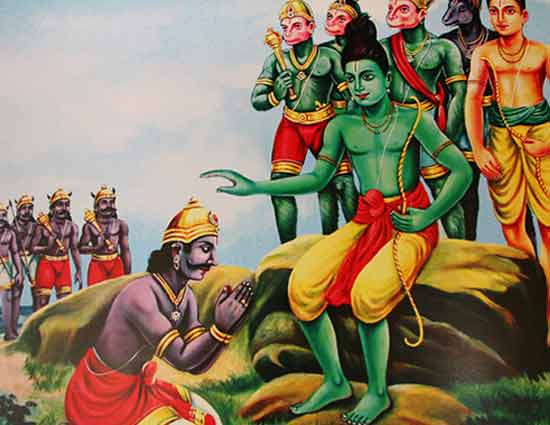Diwali Special- History Of Demon, Vibhishana Who Ruled Over Lanka
By: Kratika Maheshwari Tue, 10 Oct 2017 12:23:57

Vibhishana, was the half-bother and the youngest brother of Ravana, the demon king who ruled over Lanka. Though he was a demon by birth, he had the qualities of a Brahmin as his father was a Brahmin. After Ravana captured Sita, Vibhishana advised him to return her back, but Ravana was deaf-ears and was not ready to hear to any of his advice. So Vibhishana declares that he would leave the kingdom. But if Ravana knows about his plans then he would be in danger, so he flees away from Lanka. But before fleeing away from Lanka he calls his daughter Thirijata, who was guarding Sita in the Ashoka Gardens, and advises her to take care of Sita and his wife and Thirijata's mother Sarma very well, until Lord Rama defeats Ravana. Only, Thrijata and Sarma knew that Vibhishana had planned to join Lord Rama.
When he leaves to meet Rama, Vibhishana knew very well for what he was destined. So, while going across the ocean he carries his mace along and is accompanied by two of his favourite demons. But actually it is said that if one needs to surrender he is not supposed to carry any weapon. But Vibhishan had a purpose on carrying his mace. When he reaches the shores of Rameshwaram where Lord Ram, Lakshman, Sugreev, Hanuman and others of the monkey troop are seated, Lakshman, Hanuman and Sugreev seeing the mace in Vibhishana's hand think that he had come to attack them. But as soon as Vibhishana sees Lord Rama, he dismisses his accompanies and falls on his feet. Seeing, the mace in his hand Lord Rama understands for what Vibhishan had brought the mace and also understands the reason for his birth in the world. His internal eyes open. He understands that Vibhishana is none other than his own Mace (as Lord Vishnu has a mace in his hand), Lakshman is his Adishesha and the Conch shell and the Chakra are none other than Bharata and Shatrugna. It is said that whenever Lord Vishnu takes an avatar in this world to destroy the evil his accompaniments are also born as some human and help him out throughout his journey to fight evil.
In some period of history Sinhala people have considered Vibhishana as one of the Four Heavenly Kings (satara varam deviyo). This belief was more prominent in the Kotte period. According to the Ravana Katha of Wickramasinghe Adigar, after the defeat of Ravana, Vibhishana transferred the Yaksha capital from Alakamandawa to Kelaniya. In the 15th century poem of Thotagamuwe Sri Rahula Thera, the sælalihini sandesaya, Myna is ordered to carry the missive to Vibhishana at his temple in Kelaniya. After the 16th century, he was replaced as a God of the four warrants by the goddess Pattini. He continues to be worshipped by a diminishing number of adherents, mainly in the Kelaniya area.
Vibhishana was youngest son of Kaikesi and Sage Vishrava, who was son of Sage Pulatsya, one of the Heavenly Guardians. He(Vibhishana) was younger brother of the Lord of Lanka, Ravana and King of Sleep, Kumbakarna. Even though he was born in the demon race, he was alert and pious and considered himself a Brahmin, since his father was intuitively such.

Due to Vibhishana's differences with Ravana because he was against the act of kidnapping Sita and most of all because Ravana wanted the throne for himself, he fled Lanka. His mother, Kaikesi, advised him to go and serve Shri Rama, who was at that time assembling an army to conquer Ravana and to recover Sita. He divulged the secrets of Ravana's army and made sure Rama ended up being victorious in the great battle. Lord Rama accepted Vibhishana's service and anointed him the Lord of Lanka after Ravana's death.
In the Lanka War, Vibhishana's knowledge about the secrets of Lanka proved invaluable to Shri Rama. Vibhishana freely divulged many secrets that became key to the success of Rama's attack, including revealing the secret path to the temple of Mata Nikumbala, the family deity of the Pulatsya Clan. In the climatic battle between Rama and Ravana, when Rama was unable to kill Ravana, he revealed the secret of Ravana's death to Rama. He told Rama that Ravana has stored the nectar of immorality in his belly and it is necessary to dry it. Rama then finally killed Ravana. While modern readers tend to view the Indian epics with eyes used to seeing clearly defined good and bad characters, Ramayana's characterisation is trying to represent the practical implications of the concept of Dharma. The epic stresses that neither Vibhishana or Kumbhakarna strayed from the path of Dharma and that there is no single way out of a moral dilemma. Ramayana teaches that Kumbhakarna adhered to the Dharma of loyalty to his kin when his advice fails, while Vibhishana chose to oppose his kin when his advice failed.
Symbolically, Vibhishana represents devotion to Shri Rama and as a demon devotee, he shows that the Lord does not distinguish between his followers based on birth or circumstances in life. The same aught can be read in the story of Prahlada and Narasimha.
When Vibhishana attained the position of the King of Lanka, he turned his subjects from the path of evil to the path of Dharma(righteousness). His wife, Queen Sarama also aided him in this effort. He had a daughter named Trijata.
When Rama was about to leave Ayodhya at the end of his reign, Lord Rama in his original form of Shri Vishnu ordered Vibhishana to stay on earth and serve the people and guide them to the path of truth and Dharma. Hence, Vibhishana is considered one of the seven immortals or Chiranjeevins. Lord Vishnu also ordered Vibhishana to pray the family deity of Rama's natal Sun Dynasty, Lord Ranganatha.





